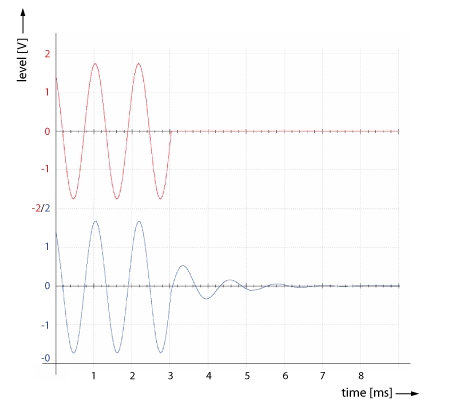KV2 Audio » Technical Talks with George Krampera » PART IV: The KV2 Art of Transducer design - The Highest possible Definition with the Lowest possible Distortion
Resonances reduce overall definition by masking smaller signals and producing tones not related to the original signal. Figure C below shows an original sine signal (red, top) with its sharply defined end and the same reproduced signal (blue, bottom), still oscillating after the signal stops due to poor control of speaker mass. Poor pulse response has a very negative effect on the ability of a speaker to reject feedback.
Figure C

Every loudspeaker used in a KV2 Audio system is specifically designed. This leads to the development of components that become the ultimate solution for their given application, not just an off the shelf driver. One of the most challenging projects undertaken by the team was the development of our new NVPD range of compression drivers. The idea came during an Italian lunch, where we discussed a new nitrate coating used in Formula One racing, offering extreme strength and rigidity. Extremely light, it is great for cars but had never been tried in pro audio. By treating the diaphragm with a Nitrate Vapour Particle Deposition (NVPD) process, the dome’s resonance and dampening characteristics are dramatically improved, lowering distortion even further and extending frequency response. By adding some of the largest Neodymium motors available today and our advanced phase plug design the result was a range of world beating high frequency units that produce distortion of less than 0.03% and measure flat up to 22kHz.
SLA systems feature exceptional feedback rejection and this in part is due to their excellent pulse response. Additionally, control over the speaker mass can be very positively impacted by using an active impedance control, (trans-coil) speaker system. This system utilizes a secondary stationary coil, which reduces inductance close to zero and dramatically improves pulse response. Inductance is the main reason for odd harmonic distortion. Odd harmonic distortion is far more audible than even harmonic distortion. Figure D below shows the effects of AIC.
Low Inductance = Low Odd Harmonic Distortion
The Active Impedance Control or AIC is an additional fixed, multi turn coil,positioned in the loudspeaker magnetic circuit gap. This coil is almost as long as the gap height and is wound around the pole piece to be very close to the primary voice coil. A current flowing into this coil generates a magnetic field that is in opposition to the field generated by the moving coil. This cancels out most of the voice coil inductance and reduces the flux modulation and inductance modulation. The AIC device can be seen as an “active” shorted ring in the gap. The two AIC terminals allow driving the additional coil in many different ways according to specific application needs.
Many audio manufacturers globally have tried to utilise KV2’s trans-coil components with little success. They fail to realise that it is a combination of both transducer and electronics design that produce KV2’s sound quality.
Read more in our Technology section.